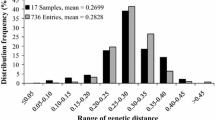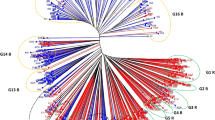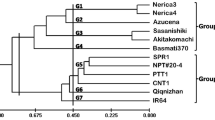Abstract
Key message
Two heterotic groups and four heterotic patterns were identified for IRRI hybrid rice germplasm to develop hybrid rice in the tropics based on SSR molecular data and field trials.
Abstract
Information on heterotic groups and patterns is a fundamental prerequisite for hybrid crop breeding; however, no such clear information is available for tropical hybrid rice breeding after more than 30 years of hybrid rice commercialization. Based on a study of genetic diversity using molecular markers, 18 parents representing hybrid rice populations historically developed at the International Rice Research Institute (IRRI) were selected to form diallel crosses of hybrids and were evaluated in tropical environments. Yield, yield heterosis and combining ability were investigated with the main objectives of (1) evaluating the magnitude of yield heterosis among marker-based parental groups, (2) examining the consistency between marker-based group and heterotic performance of hybrids, and (3) identifying foundational hybrid parents in discrete germplasm pools to provide a reference for tropical indica hybrid rice breeding. Significant differences in yield, yield heterosis and combining ability were detected among parents and among hybrids. On average, the hybrids yielded 14.8 % higher than the parents. Results revealed that inter-group hybrids yielded higher, with higher yield heterosis than intra-group hybrids. Four heterotic patterns within two heterotic groups based on current IRRI B- and R-line germplasm were identified. Parents in two marker-based groups were identified with limited breeding value among current IRRI hybrid rice germplasm because of their lowest contribution to heterotic hybrids. Heterotic hybrids are significantly correlated with high-yielding parents. The efficiency of breeding heterotic hybrids could be enhanced using selected parents within identified marker-based heterotic groups. This information is useful for exploiting those widely distributed IRRI hybrid rice parents.



Similar content being viewed by others
References
Ali ML, McClung AM, Jia MH, Kimball JA, McCouch SR, Eizenga GC (2011) A rice diversity panel evaluated for genetic and agro-morphological diversity between subpopulations and its geographic distribution. Crop Sci 51:2021–2035
Cavalli-Sforza LL, Edwards AWF (1967) Phylogenetic analysis: models and estimation procedures. Am J Human Genet 19:233–257
Dudley JW, Saghai Maroof MA, Rufener GK (1991) Molecular markers and grouping of parents in maize breeding programs. Crop Sci 31:718–723
Fischer S, Maurer HP, Würschum T, Möhring J, Piepho HP, Schön CC, Thiemt EM, Dhillon BS, Weissmann EA, Melchinger AE, Reif JC (2010) Development of heterotic groups in Triticale. Crop Sci 50:584–590
Garris AJ, Tai TH, Coburn JR, Kresovich S, McCouch SR (2005) Genetic structure and diversity in Oryza sativa L. Genetics 169:1631–1638
Griffing B (1956) Concept of general and specific combining ability in relation to diallel crossing system. Aust J Biol Sci 9:463–493
He ZZ, Xie FM, Chen LY, Dela Paz MA (2012) Genetic diversity of tropical hybrid rice germplasm measured by molecular markers. Rice Sci 19:193–201
Lanza LLB, Souza CL, Ottoboni LMM, Vieira MLC, Souza AP (1997) Genetic distance of inbred lines and prediction of maize single-cross performance using RAPD markers. Theor Appl Genet 94:1023–1030
Lin SC, Yuan LP (1980) Hybrid rice breeding in China. In: Innovative approaches to rice breeding. IRRI, Philippines, pp 35–51
Liu KJ, Muse SV (2005) PowerMarker: an integrated analysis environment for genetic marker analysis. Bioinformatics 21:2128–2129
Liu S, Chen H, Wang F, Zhu YG (2002) DNA polymorphism of main restorer lines of hybrid rice in China. Chin J Rice Sci 16:1–5
Lu ZM, Xu B (2010) On significance of heterotic group theory in hybrid rice breeding. Rice Sci 17:94–98
McNally KL, Childs KL, Bohnert R, Davidsond RM, Zhao K, Ulata VJ, Zeller G, Clark RM, Hoeng DR, Bureaug TE, Stokowski R, Ballinger DG, Frazer KA, Cox DR, Padhukasahasrame B, Bustamante CD, Weigel DW, Mackill DJ, Bruskiewich RM, Ratsch G, Buell RC, Leung H, Leach JE (2009) Genomewide SNP variation reveals relationships among landraces and modern varieties of rice. Proc Natl Acad Sci USA 106:12273–12278
Melchinger AE (1999) Genetic diversity and heterosis. In: Coors JG, Pandey S (eds) The genetics and exploitation of heterosis in crops. ASA, CSSA, and SSSA, Madison, pp 99–118
Melchinger AE, Gumber RK (1998) Overview of heterosis and heterotic groups in agronomic crops. In: Lamkey KR, Staub JE (eds) Concepts and breeding of heterosis in crop plants. CSSA, Madison, pp 29–44
Menz MA, Klein RR, Unruh NC, Rooney WL, Klein PE, Mullet JE (2004) Genetic diversity of public inbreds of Sorghum determined by mapped AFLP and SSR markers. Crop Sci 44:1236–1244
Perrier X, Jacquemoud-Collet JP (2006) DARwin software. http://darwin.cirad.fr/darwin
Reif JC, Hallauer AR, Melchinger AE (2005) Heterosis and heterotic patterns in maize. Maydica 50:215–223
Reif JC, Hao YS, Wurschum T, Gowda M, Hahn V (2013) Genomic prediction of sunflower hybrid performance. Plant Breed 132:107–114
R Development Core Team (2011) R: A Language and Environment for Statistical Computing. Vienna, Austria (http://www.R-project.org/)
Saghai Maroof MA, Yang GP, Zhang QF, Gravois KA (1997) Correlation between molecular marker distance and hybrid performance in U.S. southern long grain rice. Crop Sci 37:145–150
SAS Institute Inc (2012) SAS OnlineDoc® 9.3. SAS Institute Inc, Cary
Thomson MJ, Zhao K, Wright M, McNally KL, Rey J, Tung CW, Reynolds A, Scheffler B, Eizenga G, McClung A, Kim H, Ismail AM, Ocampo M, Mojica C, Reveche MY, Dilla-Ermita CJ, Mauleon R, Leung H, Bustamante C, McCouch SR (2012) High-throughput single nucleotide polymorphism genotyping for breeding applications in rice using the BeadXpress platform. Mol Breed 29:875–886
Troyer AF (2006) Adaptedness and heterosis in corn and mule hybrids. Crop Sci 46:528–543
Wang SJ, Lu ZM (2006a) Genetic diversity among parental lines of Indica hybrid rice (Oryza sativa L.) in China based on coefficient of parentage. Plant Breed 125:606–612
Wang SJ, Lu ZM (2006b) Evolvement and analysis of genetic diversity in indica hybrid rice (Oryza sativa L.) in China. Jiangsu J Agric Sci 22:192–198
Wang SJ, Lu ZM (2007) Study on heterosis groups of key parental lines in indica hybrid rice (Oryza sative L.) in China. J Nanjing Agric Univ 30:14–18
Xie FM (1993) Hybrid performance and genetic diversity as revealed by RFLPs in rice (Oryza sativa L.). Dissertation, Texas A&M University
Xie FM, Guo LB, Ren GJ, Hu PS, Wang F, Xu JL, Li XQ, Qiu FL, dela Paz MA (2012) Genetic diversity and structure of indica rice varieties from two heterotic pools of southern China and IRRI. Plant Genet Resour Charact Util 10:186–193
Xu WJ, Virmani SS, Hernandez JE, Sebastian LS, Redoña ED, Li ZK (2002) Genetic diversity in the parental lines and heterosis of the tropical rice hybrids. Euphytica 127:139–148
Yuan LP (1977) Practice and theory of breeding hybrid rice. Sci Agric Sin 10(1):27–31
Zhang Q, Gao YJ, Saghai Maroof MA, Yang SH, Li JX (1995) Molecular divergence and hybrid performance in rice. Mol Breed 1:133–142
Zhao K,Wright M, Kimball J, Eizenga G, McClung A, Kovach M, Tyagi W, Ali ML, Tung CW, Reynolds A, Bustamante CD, McCouch SR (2010) Genomic diversity and introgression in O. sativa reveal impact of domestication and breeding on the rice genome. PLoS One 5. doi:10.1371/journal.pone.0010780
Acknowledgments
The authors thank T. Lomas and his team from Pioneer Overseas Corporation for conducting the SSR genotyping, and Pioneer Overseas Corporation for providing full support for field trials at General Santos, Philippines and Hyderabad, India. We are grateful to D. Byron from Pioneer Hi-Bred International, Inc., for his critical reading and H. Bill from IRRI for editing of the manuscript. This research was supported by the IRRI-Pioneer Scientific Knowledge Exchange Program (SKEP) and the China Scholarship Council (Grant No. 2009325011).
Conflict of interest
This research has no conflict of interest.
Author information
Authors and Affiliations
Corresponding author
Additional information
Communicated by T. H. Tai.
Electronic supplementary material
Below is the link to the electronic supplementary material.
Rights and permissions
About this article
Cite this article
Xie, F., He, Z., Esguerra, M.Q. et al. Determination of heterotic groups for tropical Indica hybrid rice germplasm. Theor Appl Genet 127, 407–417 (2014). https://doi.org/10.1007/s00122-013-2227-1
Received:
Accepted:
Published:
Issue Date:
DOI: https://doi.org/10.1007/s00122-013-2227-1




